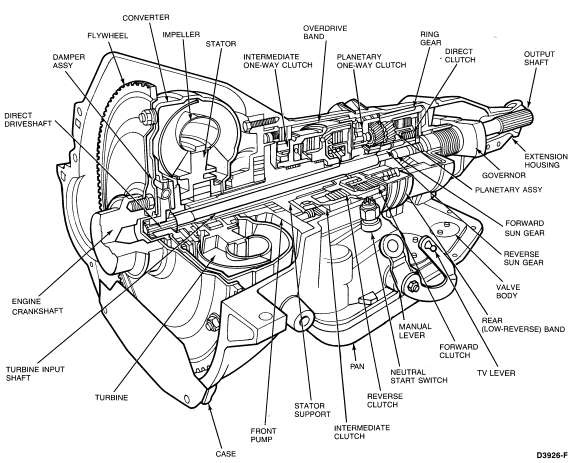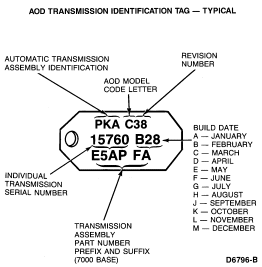
Section 07-01B: Transmission, Automatic—AOD | 1993 Mustang Workshop Manual |
The following illustration shows the location of the converter, front
pump, clutches, gear train and most of the internal parts used in the Automatic
Overdrive (AOD) Transmission. 
The Automatic Overdrive Transmission provides fully automatic operation in either the (D) (OVERDRIVE) or D (3-OVERDRIVE LOCK OUT) positions.
NOTE: A 2 (SECOND) selector position replaces the 1 (LOW) selector position in vehicles equipped with the low gear lock out position.
(D) (OVERDRIVE)—This is the normal driving position for an automatic overdrive transmission. In this position the transmission starts in first gear and as the vehicle accelerates, automatically upshifts to second, third and fourth (overdrive) gear. The transmission will automatically downshift as vehicle speed decreases.
NOTE: The transmission will not shift into or remain in overdrive gear when the accelerator is pushed to the floor.
The Automatic Overdrive Transmission differs from the conventional 3-speed automatic transmission in that the planetary gear set operates in fourth gear. Some noise may be heard while in fourth gear (overdrive). This noise may be described as a light whine, and should be considered normal. During diagnosis, care should be taken not to mistake other audible abnormal noises as normal.
D (OVERDRIVE LOCK OUT)—In this position the transmission operates as in (D) (OVERDRIVE) except there will be no shift into the overdrive gear. This position may be used when driving up or down mountainous roads to provide better performance and greater engine braking than the overdrive position. The transmission may be shifted from (D) to D or D to (D) at any vehicle speed.
1 (LOW)—This position can be used when maximum engine braking is desired. To help brake the vehicle on hilly roads where D (OVERDRIVE LOCK OUT) does not provide enough braking, shift the selector lever to 1 (LOW). At vehicle speeds above approximately 40 km/h (25 mph), the transmission will shift to second gear and remain in second gear. When vehicle speed drops below 40 km/h (25 mph), the transmission will downshift to first gear and remain in first gear. Upshifts from 1 (LOW) can be made by manually shifting to (D) (OVERDRIVE) or D (OVERDRIVE LOCK OUT). When 1 (LOW) is used for starting up, the transmission starts in first gear and stays in first gear.
FORCED DOWNSHIFTS—At vehicle speeds from 89-40 km/h (55-25 mph), in (D)(OVERDRIVE) or D (OVERDRIVE LOCK OUT), the transmission will downshift to second gear when the accelerator is pushed to the floor. At vehicle speeds below 40 km/h (25 mph), the transmission will downshift to first gear when the accelerator is pushed to the floor.
At most vehicle speeds in (D)(OVERDRIVE), the
transmission will downshift from fourth gear to third gear when the accelerator
is pushed for moderate to heavy acceleration. 